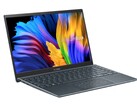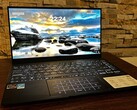OLED is fun - but it also has its downsides. This is the conclusion we reached in our review of the Zenbook 14X from Asus. On the plus side, the 14-incher has a contrast of infinity to one, unparalleled color spaces (100% P3, sRGB and AdobeRGB 98%) and a response rate in the per mille range.
The chassis of the 14-incher is right at the top in terms of value and stability. Its solid build - especially of the lid - is impressive. Combined with the thin bezel and the edge-to-edge keyboard layout, it creates a comfortable working environment in the smallest space. The keys, with a firm stroke, don't quite come close to the optimal keys of the Latitude or ThinkPad, but there's not much to fault here. We typed the entire review on these keys and can recommend the laptop for frequent typists.
Performance and emissions can be adjusted to the desired scenario: If you need computing power, you will have to live with a lot of noise under load; if laptop use is moderate, you will benefit from an almost silent office machine. For games, the Asus Performance profile should be activated to ensure that the dedicated MX450 can unfold its full potential. In turn, above-average frame rates then become possible. Asus has opted for a fast variant of this dGPU, which is noticeable in games.
The two Thunderbolt 4 ports and the solid speakers complement the model, making it just as useful for movie night as for the extensive, professional office user with a Thunderbolt dock and two external monitors. The wide clickpad with its weak drop is not to our liking. If desired, it transforms into a second display, creating an extended desktop under the keyboard. This may be useful for some people, but it may also fall into oblivion since you may simply want to continue working on 2 or 3 screens without cranking your neck in looking downwards.
Those who find something to complain about after these positive points: is this hair-splitting? Of course, we detected some points of criticism, including the glossy surface of the touchscreen, which, together with the good but not above-average brightness, severely hinders use in the sunshine. High luminance and OLED don't really get along, which is why Asus had to take the middle path here.
The second point of criticism concerns the OLED screensaver, which is necessary because of the possible burn-in effect and is activated by default by the manufacturer. Unfortunately, this increases idle power consumption for a few colorful pictures and switches on after 15 minutes - which can get on your nerves, depending on the circumstances.
The third point of criticism concerns the account-linking of all power, audio and screen settings. The user has to create a MyAsus account to access these settings. What if Dell did this? A storm of indignation would erupt if the Dell Power Manager was locked into a personalized compulsory account. Will Asus also soon lock the volume control into the private account?
The fourth point of criticism is directed at the battery life: 5:30 hours is no longer contemporary for the price range in 2022 - but the OLED competitors also suffer from short battery life. This is not because the batteries are too weak, but because of the increased power consumption of the display technology. Those who want an OLED instead of an IPS display have to give up 2-3 hours of battery life.
Unfortunately, the webcam delivers muddy images and the eShutter lacks visual feedback. Is the camera now really turned off? Here, a mechanical shutter is probably better for a feeling of security.
All details, benchmarks and measurements can be found in our detailed review. There, we also list alternatives of laptops with and without OLED that - in identical form factor - offer similar or even greater performance on account of the CPU or GPU.










